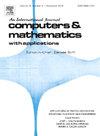基于物理信息的神经网络自适应划分的热斗篷设计
IF 2.5
2区 数学
Q1 MATHEMATICS, APPLIED
引用次数: 0
摘要
本文提出了一种基于物理信息的神经网络自适应划分方法,用于热斗篷的设计。为了实现不同形状的热斗篷结构的智能反设计,建立了自适应分层反设计PINN求解框架。与基于等效变换理论的热斗篷研究相比,将改进的PINN结构应用于反设计在一定程度上摆脱了背景导热系数的限制。因此,可以通过在一定范围内应用给定材料来设计具有相当功能的热斗篷。特别地,该方法避免了多次细分和网格重划分的必要性,同时可以获得相应的全场温度和热斗篷的层数。最后,通过对有限元结果的比较,得出了PINN-DTC制备的热斗篷结构具有较好的热防护性能。本文章由计算机程序翻译,如有差异,请以英文原文为准。
PINN-DTC: Adaptive partitioning of physics-informed neural network for designing thermal cloak
In this study, an adaptive partitioning of physics-informed neural network is proposed for designing thermal cloak (PINN-DTC). In order to realize the intelligent inverse design of thermal cloak structures with different shapes, an adaptive hierarchical inverse design PINN solution framework is established. The application of improved PINN structure for inverse design is somewhat free from the limitation of the background thermal conductivity compared to the thermal cloak research based on the equivalent transformation theory. Consequently, a thermal cloak with considerable functionality can be designed by applying a given material within a certain range. In particular, the presented method avoids the necessity of multiple subdivision and mesh redivision, and simultaneously permits the acquisition of the corresponding full-field temperature and the number of layers of the thermal cloak. Finally, comparing finite element results, the structure of the thermal cloak obtained by PINN-DTC showed superior thermal protection performance.
求助全文
通过发布文献求助,成功后即可免费获取论文全文。
去求助
来源期刊

Computers & Mathematics with Applications
工程技术-计算机:跨学科应用
CiteScore
5.10
自引率
10.30%
发文量
396
审稿时长
9.9 weeks
期刊介绍:
Computers & Mathematics with Applications provides a medium of exchange for those engaged in fields contributing to building successful simulations for science and engineering using Partial Differential Equations (PDEs).
 求助内容:
求助内容: 应助结果提醒方式:
应助结果提醒方式:


